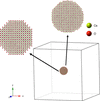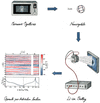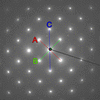issue contents
August 2024 issue

Cover illustration: Carlsen et al. [J. Appl. Cryst. (2024), 57, 986–1000] report an investigation and comparison of different algorithms from small-angle X-ray scattering tensor tomography for reconstructing the anisotropic scattering density of samples with fast directional variation.
research papers
Open  access
access
 access
accessThe influence of various combinations of residual stress, composition and grain interaction gradients in polycrystalline materials with cubic symmetry on X-ray stress analysis by energy-dispersive diffraction is discussed on the basis of simulations for ferritic and austenitic steel.
Open  access
access
 access
accessA new analysis framework to treat quasi-elastic neutron spectroscopy data recorded at discrete energy transfers has been developed. This new approach can be employed successfully for kinetic studies of diffusive dynamics.
The first observation is reported of quasi-Bragg scattering from collimating Goebel mirrors in a real instrument.
Open  access
access
 access
accessSerial crystallography (SX) requires efficient processing of numerous diffraction patterns. TORO Indexer is a high-performance indexing solution that operates across various platforms such as GPUs, CPUs and TPUs, offering high processing speed without compromising indexing quality. Its design ensures easy integration into existing software, making it a useful tool for evolving SX techniques with ever-expanding data volumes.
Download citation


Download citation


Open  access
access
 access
accessThe structural changes occurring during pyrolysis from pre-ceramic polymer to polymer-derived ceramic are traditionally challenging to characterize, and the inclusion of nanoparticle filler throughout the matrix complicates this further. In this work, the authors demonstrate the value of synchrotron X-ray scattering and pair distribution function analysis to track these structural changes with isolation of nanoparticle–matrix interactions at the local scale.
Open  access
access
 access
accessA Bayesian method is proposed for quantitatively selecting a mathematical model of a sample for small-angle scattering. The performance of this method is evaluated through numerical experiments on artificial data for a sample containing a mixture of multiple spherical particles.
Open  access
access
 access
accessLarge pixel detectors exhibit gaps which affect data analysis because of missing data, e.g. for coherent diffraction imaging (CDI). A patching-based deep-learning algorithm is proposed, which allows the missing data to be estimated for arbitrary detector dimensions when applied to Bragg CDI, thus reducing the gap-induced artifacts in the reconstructions.
Open  access
access
 access
accessAll available crystallographic information is used to train classification models for crystal systems, Bravais lattice, point groups and space groups. Reasonably accurate results can be achieved in space-group prediction if the classes used to train the models comprise more than 100 entries.
Open  access
access
 access
accessThe article reports an investigation and comparison of different algorithms from small-angle X-ray scattering tensor tomography for reconstructing the anisotropic scattering density of samples with fast directional variation. The different methods are tested using wide-angle scattering data from an as-drawn steel wire.
Open  access
access
 access
accessA combination of electron backscatter diffraction and small-angle X-ray scattering analyses was employed to index all main axes and faces of an α lath not only in the cubic coordinate system of the parent β phase but also in the hexagonal system of the α phase.
A recently published probabilistic theory estimates triplet invariants by using the Patterson peaks as prior information. This paper is the first experimental test: it is shown that the new estimates are so accurate that they may be applied to macromolecules. Structural complexity and atomic data resolution are no longer critical limits.
Data reduction and analysis approaches targeting whole-nanoparticle atomistic refinements from neutron total-scattering data are discussed. Refinements performed using the reverse Monte Carlo method are illustrated with the structural characterization of doped ceria nanoparticles.
Open  access
access
 access
accessThe performance of the wide-angle neutron scattering option on pinhole small-angle scattering instruments to measure data over a wide angular range with variable resolution can be assessed by comparison with the McStas simulation of ideal experimental conditions on the instrument.
A deep learning approach has been developed for analyzing small-angle scattering data, effectively addressing the potential inversion problem in colloids. The method is validated using both simulation results and experimental spectra of charged silica suspensions and is shown to outperform existing approaches in accuracy and efficiency. This study highlights the potential of deep learning in soft-matter research.
Assuming that the errors affecting crystal rotations are random, formulae for the average and maximum errors of rotation axes are provided.
Open  access
access
 access
accessLaboratory powder diffraction and microtomography techniques are sequentially used in the same volume of the same sample to study the process of cement hydration with time.
Open  access
access
 access
accessThis paper proposes a phase-retrieval algorithm for X-ray ptychography with almost the same computational efficiency as the conventional methods. It exploits an optimization technique, subgradient projection, which has an interesting property that means it can be expected to avoid yielding poor images.
Open  access
access
 access
accessThis article explores widely used approaches for two-time correlation calculations and common methods for extracting relevant information from correlation functions. The results are applicable to a wide range of processes including growth and coarsening.
Open  access
access
 access
accessThis paper demonstrates an event-mode imaging based neutron diffraction detector system that employs a scintillator screen, an image intensifier and a Timepix3-based camera. This highly configurable approach allows for large-solid-angle low-cost neutron diffraction setups with a performance comparable to that of the 3He detectors on a time-of-flight neutron diffraction beamline.
A procedure for determining the degree of crystallinity of composite materials has been developed, and its application to partially crystallized polyphenylene sulfide samples, composited with CaCO3 as a crystalline filler and e-glass as a non-crystalline filler, is demonstrated. The inverse application of the direct derivation method for quantitative phase analysis is used to separate the halo pattern intensity into the non-crystalline part of the polymer and the non-crystalline filler.
Open  access
access
 access
accessFull pattern analyses of small-angle X-ray and neutron scattering data with both discrete reflections and central diffuse scattering are presented. Data with both equatorial streaks and two- and four-point reflections can be fitted in elliptical coordinates with relatively few parameters.
An X-ray optical device with fine nanostructure was fabricated using an electrochemical approach. This device contributed to improvement of the spatial resolution when used as an optical element for X-ray diffraction imaging.
Substrates with switchable magnetic contrast layers can significantly improve polarized neutron reflectometry investigation of soft-matter objects.
Open  access
access
 access
accessA function and coefficients for computing resonant neutron scattering lengths for selected elements and isotopes are described.
Open  access
access
 access
accessThis paper demonstrates the `rare event indicator', a robust machine learning framework to detect the onset of plastic deformation in polycrystalline materials.
Open  access
access
 access
accessThis article provides a demonstration of tools for operando pair distribution function analysis of nanocrystalline functional materials. The particular case used is 3 nm TiO2-bronze nanocrystals as active electrode material in a Li-ion battery.
The field-induced transition of lead hafnate to the polar phase was observed for the first time by in situ diffraction. The obtained field dependencies of reflections in the reciprocal space of the sample have a number of interesting features which allow us to expand our understanding of domain kinetics in this type of material.
AutoRefl is an active learning algorithm for neutron reflectometry measurements that maximizes the information acquisition rate in specific model parameters, thereby improving measurement speeds. Its forecasting capability is particularly useful for integration with data acquisition systems without loss of data quality.
short communications
Open  access
access
 access
accessThis article presents an investigation into the feasibility of X-ray powder diffraction of macromolecules with laser-driven X-ray sources, which may enable in-house sub-picosecond time-resolved structural studies of macromolecules.
Annealing-induced structural transformations in titanium–chromium oxide crystals potentially highlight a role in modulating thermal conductivity through the regularization of crystallographic shear plane spacing.
computer programs
Open  access
access
 access
accessTools have been implemented for rapid X-ray diffraction data processing and analysis for dynamic compression experiments using a diamond anvil cell.
Open  access
access
 access
accessThis paper presents DFT2FEFFIT, an open-source Python-based program that regresses theoretical EXAFS spectra calculated from density functional theory structure models against experimental EXAFS spectra. DFT2FEFFIT could be of use for researchers involved in various fields of solid-state chemistry, physics and mineralogy.
An illustration is given of the use of the Cambridge Structural Database (CSD) Python API in the community with some example cases.
Open  access
access
 access
accessThis paper presents the new RMCProfile7 program for reverse Monte Carlo big-box modelling of multiple-phase systems.
laboratory notes
Open  access
access
 access
accessReexamination of the well known Rn ratio method for indexing electron diffraction zone axis patterns of materials with cubic symmetry has revealed some unrecognized potential for zone axis direction analysis and, in some cases, unambiguous identification of the Bravais lattice. A protocol has been developed which allows the identification of experimental spot patterns for the 15 most common zone axis directions.

 journal menu
journal menu























































